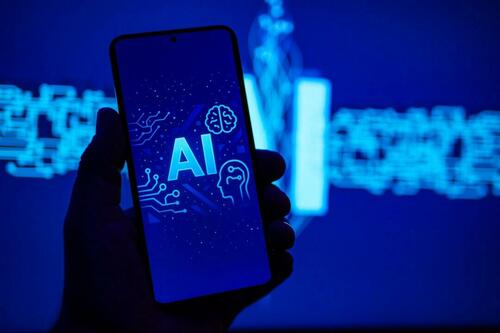AI Taking Its Toll On Jobs – What To Know
Authored by Panos Mourdoukoutas via The Epoch Times (emphasis ours),
Some major companies have recently triggered a wave of layoffs, eliminating tens of thousands of jobs. Most cited artificial intelligence (AI) integration and automation as factors behind these moves.

Experts say that while a significant portion of jobs cannot be replicated by machines, AI will likely usurp white-collar analytical roles and robotics will replace manual labor jobs.
Amazon announced on Oct. 28 that it will eliminate about 14,000 corporate positions to stay “nimble.”
UPS, meanwhile, revealed that it had cut 34,000 operational jobs during the first nine months of this year—a significantly larger reduction than the 20,000 layoffs announced in April—as part of its “efficiency reimagined” initiative.
Nestlé said on Oct. 16 that it will reduce 16,000 jobs worldwide over the next two years in an effort to achieve “operational efficiency” by “leveraging shared services and automating [its] processes.”
In August, Salesforce CEO Marc Benioff disclosed on an podcast that the company had replaced about 4,000 customer support workers with AI agents.
In the past, businesses typically downsized during economic downturns, but these recent staff reductions occurred during a period of robust profitability, signaling something different—a transformation in the way work itself is organized, driven by the rapid diffusion of AI.
Unlike past automation waves that mimicked the functions of the human body—replacing manual or routine tasks—AI targets the human brain’s cognitive abilities. It doesn’t just perform repetitive processes; it learns, analyzes, and makes decisions.
Together, these twin shifts—manual automation and cognitive automation—are remaking both unskilled and skilled labor. The result: some jobs are being transformed, others are being cut.
In a statement included in its job cut announcement, the company explained that AI’s transformative force requires new organizational structures: “It’s enabling companies to innovate much faster than ever before … We’re convinced that we need to be organized more leanly, with fewer layers and more ownership, to move as quickly as possible for our customers and business.”
However, Amazon CEO Andy Jassy said during the company’s Oct. 30 earnings call that the recent layoff announcement was not “really AI-driven, not right now, at least.”
AI Diffusion Across the Workforce
Economists, central banks, and think tanks have documented AI’s rapid spread across workplaces.
A report by the Federal Reserve Bank of St. Louis found that by early 2023, generative AI—the class of AI capable of creating new content—had become widespread across the American workforce. Tools such as ChatGPT were embedded in browsers, office software, and search engines, making large language model usage routine for millions of workers.
The bank found that occupations adopting generative AI most intensively—particularly computer and mathematical fields—experienced the steepest unemployment gains.
“Our results suggest we may be witnessing the early stages of AI-driven job displacement,” the report noted. “Unlike previous technological revolutions that primarily affected manufacturing or routine clerical work, generative AI can target cognitive tasks performed by knowledge workers—traditionally among the most secure employment categories.”
A Brookings Institution report estimates that 30 percent of all U.S. workers could see at least half of their job tasks disrupted by generative AI. Unlike earlier automation, which primarily affected blue-collar work, AI is expected to reshape a broad range of “cognitive” and “nonroutine” occupations—especially those in middle- and high-income professions.
Similarly, the McKinsey Global Institute has projected that automation (a combination of AI and robotics) could displace up to 54 million workers in the United States by 2030.
Meanwhile, a Goldman Sachs analysis projects that widespread AI adoption could displace 6 to 7 percent of the U.S. workforce, equivalent to millions of jobs.
Goldman Sachs economists estimate that temporary unemployment spikes by roughly 0.3 percentage points for each percentage-point gain in productivity from labor-saving technology.
Jobs Most at Risk
A Society for Human Resource Management study, published on April 25, offers a detailed snapshot of U.S. employment exposure to AI.
According to the report, 12.6 percent of jobs—approximately 19.2 million positions—face a high or very high risk of automation-related displacement. Among them, 14 percent of blue-collar jobs, 12.3 percent of white-collar jobs, and 12.1 percent of service-sector jobs are considered at high risk.
Meanwhile, a June 9 report from the freelance work platform Upwork identifies 120 jobs that are hard to be replaced by AI, including clinical, creative, and skilled trades roles.
AI and Changing Nature of Skills
A December 2024 Harvard Business School paper shows that AI has a mixed impact on businesses’ labor demand.
In automation-prone roles, AI reduces the need for specialized expertise by simplifying complex tasks. In augmentation-prone roles, however, it boosts productivity and increases demand for advanced, complementary skill sets.
“As generative AI continues to evolve, understanding its heterogeneous effects on labor demand is critical,” the authors wrote. “Policymakers and business practitioners must recognize the dual forces of automation and augmentation to ensure that workers are equipped to adapt and thrive.”
At the same time, research by Nobel laureate Daron Acemoglu and colleagues—published in the Journal of Labor Economics—shows that as establishments adopt AI, they reduce hiring in non-AI positions and shift skill requirements across remaining roles.
Andy Zenkevich, founder and CEO of Epiic, a digital agency specializing in generative engine optimization (GEO), told The Epoch Times that the fear of mass AI-driven job losses is overstated.
“Among the companies we work with in digital marketing—including major tech firms—layoffs haven’t been the story,” he said. “Instead, jobs are morphing. A junior copywriter becomes an ‘AI content editor,’ responsible for prompt engineering, fact-checking, and editing AI-generated copy.”
Zenkevich estimated that roughly 2.5 percent of jobs are genuinely at risk under a full-scale AI rollout, noting that “true end-to-end automation is much harder than headlines suggest.”
“Over a third of jobs now require hybrid skill sets that combine technical literacy with human qualities machines can’t replicate,” he said.
Georgios Koimisis, associate professor of finance at Manhattan University, echoed a similar skepticism.
“There’s a growing fear that artificial intelligence is wiping out jobs, but the reality is more complex,” he told The Epoch Times. “Companies aren’t cutting workers simply because AI made them redundant. In an uncertain economy, firms want to appear modern and future-ready. Announcing an ‘AI transformation’ reassures investors that management has a plan.”
Koimisis argues that some layoffs, framed as part of AI restructuring, are more about signaling discipline to shareholders than about reflecting genuine technological necessity.
“AI is changing not just how work is organized, but how value itself is defined,” he said.
Izhar Haq, director of the School of Professional Accountancy at Long Island University, agrees that the slowing economy and business cycle are also contributing factors to recent job reductions.
Haq told The Epoch Times that while the long-term economic effects of AI remain uncertain, “white-collar analytical jobs are most at risk from AI integration, while manual labor jobs face risk from robotics.”
Tyler Durden
Mon, 11/03/2025 – 17:40ZeroHedge NewsRead More





 T1
T1


